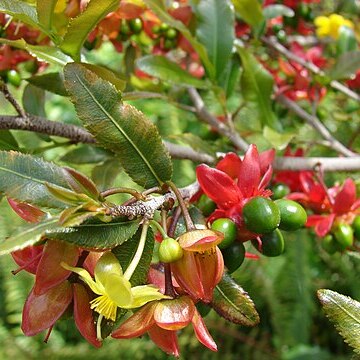Trees or shrubs with spreading branches. Stipules small, intrapetiolarly united, caducous. Leaves shortly petiolate, serrate to ciliate, rarely entire; chartaceous or subcoriaceous; nerves curved upward, especially near the margin, not joining; veinlets at ±90° to the nerves near the midrib and joining in irregular secondary nerves, ±transverse near the margin. Inflorescence mostly lateral or terminal thyrses with a terminal flower, sometimes lateral, simple cymes; peduncle ±persistent, with small axillary buds, sometimes branching once or twice after flowering and developing new inflorescences; bracts caducous, leaving a distinct annulus of scars; pedicels filiform, articulated. Flowers with a ±hemispherical, distinctly tumid torus, becoming red in fruit. Sepals 5, greenish, greatly enlarged and becoming red in fruit. Petals 5 (rarely to 10), yellow or white. Stamens numerous in 2 or more whorls, free; filaments subterete; anthers opening with 2 apical pores. Carpels (4–)5–15, 1-ovulate; styles slender, gynobasic, basally united. Stigmas as many as ovaries, on short branches or ±united. Fruit of 1–several, free druplets; druplets with fleshy mesocarp, greenish, turning black when ripe, inserted on an enlarged, red receptacle.
Shrubs or treelets, sometimes undershrubs. Stipules small, intrapetiolarly united, caducous. Leaves shortly petioled, chartaceous or subcoriaceous; nerves curved upward, especially near the margin, not joining; veinlets ± at right angles to the nerves near the midrib and joining in irregular secondary nerves, ± transverse near the margin. Inflorescences lateral or terminal thyrses with a terminal flower; peduncle ± persistent, bearing many, small, distichously conferted, caducous bracts at base, leaving a distinct annulus of scars; pedicels filiform, articulate. Flowers with ± hemispherical torus, distinctly tumid and red in fruit. Sepals 5, greenish, accrescent and turning red in fruit. Petals 5-10, in 1-2 whorls, yellow. Stamens ∞ in 2 or more whorls; filaments subterete; anthers opening with 2 apical pores. Ovaries 5-10(-15), obovoid; ovule atropous; stigmas as many as ovaries, on short branches or ± united. Fruits 1-3(-5), greenish, turning black when ripe.
Small trees or shrubs. Stipules small, intrapetiolarly united, deciduous; leaf blade simple, margin generally serrate, rarely entire; secondary veins curved upward, especially near margin, not joining in a submarginal vein. Inflorescences branched, sometimes corymbose. Sepals (4 or)5, completely enclosing floral bud, margins entire, often accrescent and colored in fruit, persistent. Petals 5-12, yellow or rarely orange or white, contorted. Stamens numerous, 2-or more whorled; filaments short or elongate, persistent; anthers poricidal or more rarely longitudinally dehiscent. Ovary deeply lobed, 3-15-locular; ovule 1 per locule; style gynobasic, slender; stigma generally slightly lobed. Drupelets 3-10(or 15), black, inserted on accrescent receptacle. Seed non-endospermic; embryo straight or curved.
Seeds straight or ± curved or reniform, cylindric or somewhat flattened but not angular, without endosperm or an internal projection of the endocarp; embryo straight or curved, incumbent or accumbent, isocotylous or heterocotylous.
Inflorescence paniculate to racemose or umbellate or reduced to a single flower, terminal or terminating short axillary shoots; bracts scale-like, caducous; pedicels articulated at or above the base.
Leaves petiolate; lamina with margin serrate to ciliate or rarely entire; stipules entire or with ciliate or fimbriate margins or ± deeply bifid, not striate, free, deciduous or caducous.
Stamens (14) 20-?, free; anthers yellow, dehiscing by longitudinal slits or terminal pores, deciduous; filaments ± slender, longer or shorter than the anthers, persistent.
Carpels (3) 5–15, apparently free at the base, 1-ovulate; styles slender, gynobasic, united except sometimes towards the apex; stigmas terminal, enlarged.
Sepals (4) 5, quincuncial in bud, green or yellow in flower, persistent, enlarging and becoming varying shades of red and coriaceous in fruit.
Fruit 1 to several free black 1-seeded drupelets with fleshy mesocarp, inserted on the enlarged red receptacle.
Petals 5 (rarely up to 12), yellow or rarely orange or white, often unguiculate, deciduous.
Trees, shrubs or shrublets, usually completely glabrous.

